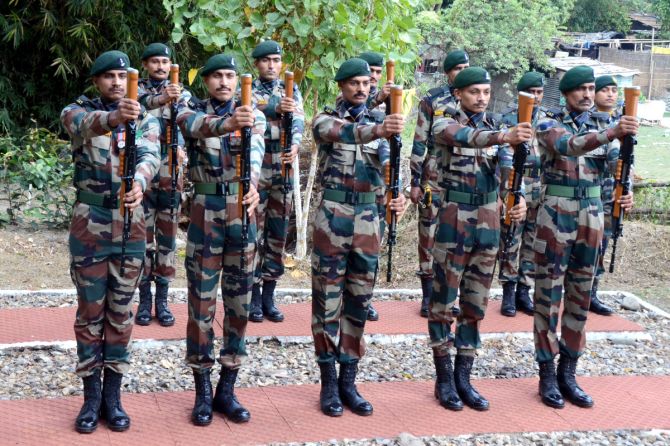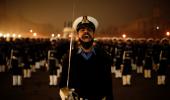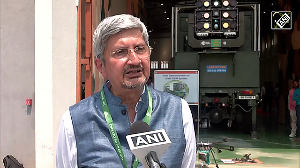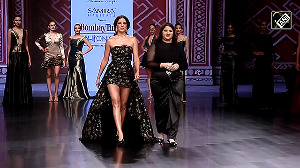Like most army combat uniforms, this one has been designed to serve two requirements: First, protection against harsh climatic conditions, including extreme heat and cold.
Second, the need to provide soldiers' outfits with field camouflage, so as to increase his battlefield survivability.
Ajai Shukla repors.

On January 15, the new combat uniform of the Indian Army will make its debut appearance during the annual Army Day parade in New Delhi.
The new uniform has been designed by the National Institute of Fashion Technology in partnership with the Indian Army.
Like most army combat uniforms, this one has been designed to serve two requirements: First, protection against harsh climatic conditions, including extreme heat and cold. Second, the need to provide soldiers' outfits with field camouflage, so as to increase his battlefield survivability.
The tradition of military field uniforms was brought to India through the British East India Company, which carved up the country into three separate presidencies -- the Bengal presidency, Bombay presidency and Madras presidency.
The British East India Company instituted separate dress uniforms and combat uniforms for each of the three presidencies. The sepoy (sipahi) soldiers who served the British were put into uniforms that were, as per British tradition, partly red. However, their uniforms were also embroidered with coloured trimmings of red (Bengal presidency), grey (Bombay presidency) and yellow (Madras presidency).
While these splashes of colour were especially visible in ceremonial dress uniform and mess dress uniform, each presidency's daily combat dress uniform also often bore edgings of their respective colours.
In times of dire emergency, such as when Indian troops in Meerut rose in rebellion on May 10, 1857, after the British introduced cartridges lubricated with the fat of cows and pigs, it became essential for the British to quickly raise uniformed forces to quell the mutiny.
The method adopted in the Punjab was to raise cavalry units called risalas. This method, known as the 'silladar' system, recruited soldiers who brought along their own weapons, equipment and horses. Instead of a salary, these fighters were permitted to keep the loot that came their way.
Since there was no time to arrange for uniforms for these ad hoc soldiers, they were identified by ad hoc methods, such as coloured sashes or turbans.
For example, one of the most effective and feared silladar units, known as Hodson's Horse after its founder, Major W S R Hodson, required its soldiers to wear scarlet cummerbunds (waist sashes) and turbans to identify itself in battle.
With one British officer observing that the unit's scarlet accoutrements made it look like a flight of flamingos as it galloped into battle, the unit adopted the nom de guerre of 'The Flamingos'. This unit, now an armoured tank regiment, still bears that informal appellation.
After 1857, the armies of the three presidencies of the East India Company devolved to the British crown and, in successive waves of restructuring, were allotted formal uniforms.
However, in several cases, the army retained in its uniforms reminders of excellence and of ethnic origin, such as the khukri -- a deadly curved knife that Gurkha soldiers carry even today on their belts.
With the division of the Indian Army into the Indian and Pakistani armies in 1947, there were major changes to the uniforms each army wore.
While these were relatively limited in the Indian Army's uniforms, which retained olive green as the basic colour of its uniform, the Pakistan army uniforms underwent major changes with the basic colour of its uniform being changed to khaki.
Changes were also made in the rank badges and unit insignia, with the British crown being replaced by the crescent in the Pakistan army and by the Ashoka emblem in the Indian Army.
The Indian Army made its next round of major changes in uniform after the 1962 War, when it found its clothing and equipment utterly inadequate for functioning and fighting in the high mountains of Ladakh and the North East Frontier Agency (now Arunachal Pradesh).
Indian soldiers's cotton uniforms and cotton fibre jerseys were replaced by clothing that was better equipped for those Himalayan altitudes.
The Indian Army's next qualitative jump began with the Siachen Glacier face-off in 1984, when Indian soldiers occupied the frozen heights of the Saltoro Ridge that towers above the glacier.
Indian units in the glacier were introduced to Austrian alpine clothing and climbing equipment and, to this day, India buys its extreme cold weather clothing (ECWC) from European alpine suppliers.
Only on December 27, 2021, did the Defence Research and Development Organisation chief hand over technology for manufacturing ECWC to five Indian companies in New Delhi.
In 1980, the Indian Army made its next big change in uniforms, replacing the old cotton olive green combat dress with 'disruptive pattern' battle dress that provided an in-built element of camouflage to the soldier.
With the latest changes, an open tender is planned to be issued to both private and public sector companies for manufacturing and supplying the new disruptive pattern battle dress uniform (BDU).
To ensure security, tight restrictions would be imposed on the manufacture and supply of this BDU and on who would be allowed to wear it.












 © 2025
© 2025